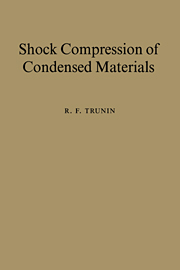7 - Compression of organic solids
Published online by Cambridge University Press: 03 December 2009
Summary
The interest in organic materials is driven by several factors, one of which is their extensive application to devices operating under extreme conditions of high pressure and temperature, and information about their thermodynamic parameters in this region is essential. The second field of their application, which is no less important, is high-pressure chemistry. It is known that shock triggers various chemical transformations in many organic materials. Their nature is not clear, and investigation of physical processes in these reactions is an urgent problem addressed by researchers.
The primary topic is a classification of Hugoniots in accordance with classes of organic materials aiming to separate their common and distinctive features. Besides, it is virtually impossible to study all types of organic materials, therefore some classification of their properties is of great importance.
Generally speaking, few organic materials have been studied under shock compression in comparison to other solids, some of which were reviewed in previous sections. Therefore any new research on them is very interesting.
We measured the shock compressibility of six organic acids and three anhydrides [112] and also four polymers and one saturated hydrocarbon [46, 113–117]. They belong to the following groups: the succinic HOOC(CH2)2COOH and glutaric HOOC(CH2)3COOH acids are saturated dibasic acids; palmitic acid C13H27COOH is monobasic; maleic acid HOOCCH2COOH is a nonsaturated diacid; tartaric or dihydroxysuccinic acid is HOOC(CHOH)2COOH; and phthalic acid is orthophenylenecar-boxylic diacid. The anhydrides were phthalic, succinic (CH2CO)2O, and myristic (C13H28CO)2O. Tetracosane has the formula C24H50 (CnH2n+2) n = 24), polyethylene (-CH2-CH2-), polytetrafluo-rethylene (-CF2-CF2-)n, polymethylmethacrylate (C5H8O2)n, and paraffin is a mixture of heavy saturated hydrocarbons, CnH2n+2, with n > 20.
- Type
- Chapter
- Information
- Shock Compression of Condensed Materials , pp. 137 - 141Publisher: Cambridge University PressPrint publication year: 1998



